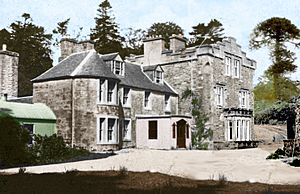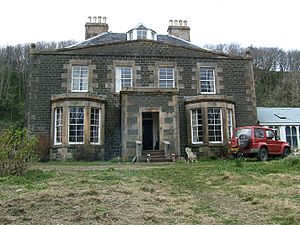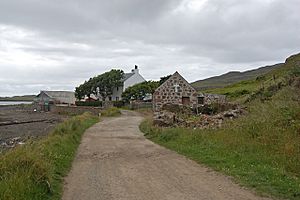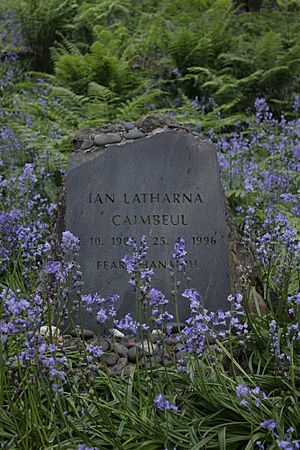John Lorne Campbell facts for kids
John Lorne Campbell (born October 1, 1906 – died April 25, 1996) was a Scottish historian, farmer, environmentalist, and folklorist. He was also a well-known expert in Celtic studies and Scottish Gaelic literature. He spent much of his life working to preserve the rich culture and language of the Scottish Highlands and Islands.
Contents
Growing Up in Scotland
John Lorne Campbell was born in Edinburgh, Scotland, in 1906. Soon after, he moved to Inverneill House on the west shore of Loch Fyne in Argyll. His family had a long history, and he was related to General Sir Archibald Campbell, who bought the Inverneill estate. John Lorne Campbell always admired General Campbell and kept his portrait and teapot in his home.
His father was Lieutenant Colonel Duncan Campbell, and his mother was Ethel Harriet Waterbury, a wealthy American from New Jersey. She married his father to help with the family's finances.
John grew up in a family that was part of the wealthy landowners in Argyll. They were members of the Scottish Episcopal Church and had strong pro-British views. He went to school at Cargilfield School in Edinburgh and then Rugby School in England.
When he turned 21 in 1927, there was a big party at Taynish House. The people who lived and worked on his family's estate, many of whom he had never met, gave him a gold pocket watch and cufflinks. John was very touched by this gift. He had learned a few words of Gaelic for the occasion and said, "Tha mi gle thoilichte a bhith comhla ribha nochd." This means, "I am very pleased to be with you tonight." The warm reaction he received made a big impression on him.
A Champion for Scottish Culture
In 1926, John's interest in the Scottish Gaelic language grew when he visited the Highland Games in Oban. He heard people speaking Gaelic and thought, "That's something I should have!"
He started studying at St John's College, Oxford, focusing on Rural Economy and Celtic studies. He hoped to learn how to manage his family's estate. However, in 1928, he was very upset to learn that the Inverneill estate had to be sold to pay off his father's debts. He kept the gold watch and cufflinks from the tenants as a reminder of what could have been.
After graduating in 1929, John developed a deep love for the Scottish Gaelic language and Scottish folklore, thanks to his professor, John Fraser.
In 1933, John published an important book called Highland Songs of the Forty-Five. This book contained 32 Gaelic song-poems he found in libraries. He translated them into English and explained their political meaning. At the time, many stories about the Jacobite rising of 1745 were romanticized. John wanted to show the real reasons behind the uprising and give a voice to the ordinary people who fought in it.
He also challenged common ideas that people who spoke Celtic languages were always sad or uneducated. He showed that Jacobite war poetry was very smart and full of references to old myths and the Christian Bible.
John strongly disagreed with his own ancestors' support for the British government against the Jacobites. He wrote that the 1745 Rising was a natural reaction against what he saw as a harsh campaign against the religion and language of Highlanders.
In the mid-1930s, John lived on the island of Barra in the Hebrides with author Compton Mackenzie. On Barra, he became close friends with a local storyteller named John The Coddy MacPherson. John The Coddy would encourage Campbell to keep speaking Gaelic, even when he struggled.
While on Barra, John and Compton Mackenzie also started the Sea League to help local fishermen. They even organized a successful protest where car owners refused to pay taxes until the island's roads were fixed. These actions helped improve government services in the Western Isles.
Marriage and Island Life
In 1934, John met his future wife, Margaret Fay Shaw, an American ethnomusicologist (someone who studies music from different cultures). They met on South Uist during a very rainy evening. At first, they didn't get along, but they soon realized they shared many interests.
They married in June 1935 in Glasgow. The entire ceremony was in Scottish Gaelic, and Margaret only had to say "Tha" ("Yes"). Neither of their families attended, but a family friend gave the bride away. They spent their honeymoon in Norway before returning to Scotland.
Folklorist, Naturalist, and Laird of Canna
In 1936, John began studying insects, especially their movements. He collected many different species on Barra and later on Canna. His collection includes rare moths and other interesting finds.
John's work in collecting and publishing Scottish Gaelic folktales helped the Irish Folklore Commission realize that oral traditions were still alive in the Highlands. This led to a long partnership between John and the Commission.
In 1937, the Campbells traveled to Nova Scotia, Canada, with a special recording machine called an Ediphone. They recorded 95 traditional Gaelic songs and stories from Canadian Gaelic speakers. John also met Gabriel Syllibuy, the Chief of the Mi'kmaq people, and recorded him telling a story in the Mikmaq language about the first Gaels arriving in the area. They also recorded Mi'kmaq people singing hymns.
These recordings were later written down as musical notes and published in a book called Songs Remembered in Exile. During their trip, they also met Fr. Moses Coady, who started the Antigonish Movement, which helped communities work together to improve their lives. John admired his ideas and thought they could help Scotland too.
In 1938, John and Margaret bought the island of Canna, south of Skye. They moved into Canna House and lived there for 40 years. John farmed the island and turned it into a safe place for wildlife. He also continued to research local history and folklore, always trying to make life better for the people on Canna. The Campbells kept recording the disappearing Gaelic heritage and published many books about Highland culture and literature.
A Change in Faith
In 1946, John Lorne Campbell became a Roman Catholic at St. Ninian's Cathedral in Antigonish, Nova Scotia. He explained that he disliked how Protestantism had influenced British politics in the past, leading to a very centralized British government. He also said his research into Highland culture led to many friendships with Catholic priests and people. He also preferred the traditional Latin Mass.
John would often jokingly call himself a "Papist" (a term sometimes used for Catholics) and express his admiration for the Jacobite risings and Scottish nationalism. His wife, Margaret, also became Catholic a few years later.
After becoming Catholic, John became very interested in the Gaelic poet Fr. Allan MacDonald. He spent over 20 years finding and publishing Fr. Allan's missing poetry, diaries, and folklore notes. John is credited with bringing Fr. MacDonald's important work back to light.
John also continued to research and promote the work of the war poet Alasdair mac Mhaighstir Alasdair, who was a captain in the Jacobite Army and a Gaelic tutor to Prince Charles Edward Stuart. John greatly admired him but was critical of how editors had changed Alasdair's poems over the years to make them seem less controversial.
Later Life and Legacy
In 1946, a folklorist named Calum Maclean came to the Hebrides to systematically collect folklore, with John's help. This work later continued for the School of Scottish Studies.
In 1961, John published Stories from South Uist, which he had collected from a storyteller named Angus MacLellan. He also published Angus MacLellan's autobiography, The Furrow Behind Me, in the same year.
John self-published the first collection of Fr. Allan MacDonald's Gaelic poems in 1965. These books were very popular, especially on the island of Eriskay, where many people still spoke Gaelic and had known Fr. Allan MacDonald.
For much of the 1970s, John fought hard to keep ferry service to Canna. He believed it was vital for the islanders to stay connected to the outside world. He felt it was his duty as a "Highland laird" to protect his tenants and employees.
In 1981, John donated Canna to the National Trust for Scotland, but he continued to live on the island.
In 1990, he was awarded an OBE (Order of the British Empire) by Queen Elizabeth II. He chose not to go to the palace for the ceremony, perhaps because of his strong Jacobite views. Instead, the Duke of Argyll came to Canna to present the award.
In 1992, John received a special knighthood from the Pope. This award pleased him the most, as it came from the Catholic priests in the islands and West Highlands, whom he greatly respected.
John Lorne Campbell died on April 25, 1996, in Italy. He was first buried there, but in 2006, his body was brought back to Canna and reburied in a birch wood he had planted near St. Columba's Roman Catholic chapel. A special headstone was placed with the inscription:
- Iain Latharna Caimbeul
- 1. 10. 1906 - 25. 4. 1996
- Fear Chanaidh
This means "John Lorne Campbell, 1 October 1906 - 25 April 1996, Man of Canna."
His wife, Margaret, continued to live at Canna House until she passed away in 2004 at the age of 101.
John Lorne Campbell and Margaret Fay Shaw worked together to create an amazing collection of Scottish and Canadian Gaelic folklore, songs, and poetry. This includes old writings, sound recordings, photos, and films. Their three-volume collection of Hebridean folk songs is a very important resource. Their entire collection at Canna House is now owned by the National Trust for Scotland and is a valuable source for scholars, musicians, and folklorists. Many of their old wax cylinder recordings are being digitized by the British Library and are available online.
The recent growth of Scottish nationalism and the efforts to revive the Scottish Gaelic language through immersion schools are also part of John Lorne Campbell's lasting impact.







